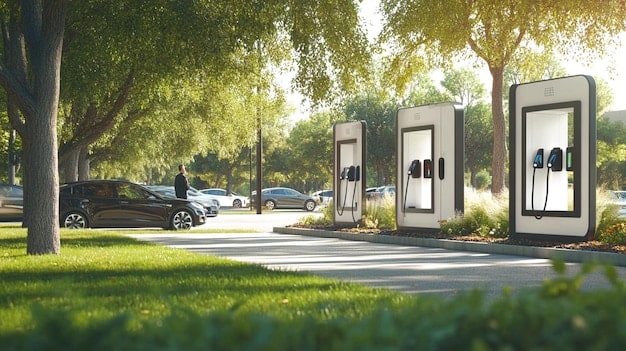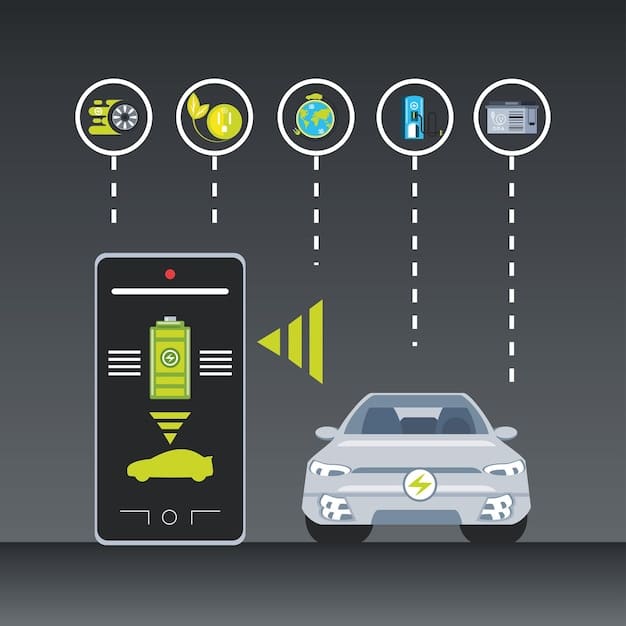Electric Vehicle Charging: Latest US Innovations Boosting Efficiency

Electric Vehicle (EV) charging infrastructure in the US is undergoing rapid innovation, with new technologies like smart charging, battery swapping, and wireless charging aiming to increase efficiency by at least 10% and address range anxiety among EV drivers.
The rise of electric vehicles (EVs) is undeniable, but a major hurdle remains: charging infrastructure. To truly embrace EVs, we need efficient, reliable, and widespread charging solutions. The good news? The US is seeing a surge of innovation in this field, with the potential to significantly improve the EV experience. Let’s explore the latest advancements pushing the boundaries of electric vehicle charging infrastructure in the US: what are the latest innovations increasing efficiency by 10%?
Smart Charging: Optimizing Energy Use
Smart charging is revolutionizing how EVs draw power from the grid. It’s not just about plugging in and charging; it’s about intelligently managing energy flow to minimize costs and maximize efficiency.
What is Smart Charging?
Smart charging encompasses technologies that allow EVs to communicate with the grid and adjust their charging rates based on various factors.
Benefits of Smart Charging
Smart charging presents several advantages, including lower energy costs for EV owners and reduced strain on the electricity grid.
- Reduced peak demand: Smart charging can shift EV charging to off-peak hours, when electricity is cheaper and more readily available.
- Grid stabilization: By coordinating charging, smart grids can help balance the electricity supply and demand, preventing blackouts and brownouts.
- Renewable energy integration: Smart charging can prioritize charging EVs when renewable energy sources, such as solar and wind, are generating excess power.

Smart charging is essential for a future powered by renewable energy and supported by electric vehicles. It ensures that EVs are not just a clean transportation option, but also an asset to the energy grid.
Wireless Charging: Convenience and Accessibility
Imagine charging your EV simply by parking it over a designated spot. Wireless charging is making this vision a reality, offering unparalleled convenience and accessibility.
How Wireless Charging Works
Wireless charging, also known as inductive charging, uses electromagnetic fields to transfer energy from a charging pad to a receiver in the EV.
Advantages of Wireless Charging
Wireless charging offers a seamless charging experience, eliminating the need for cables and plugs. It is particularly convenient for public charging locations and could potentially be integrated into roads for dynamic charging.
- Ease of use: No need to fumble with cables – simply park and charge.
- Aesthetic appeal: Wireless charging pads can be integrated seamlessly into the environment, without the clutter of charging cables.
- Potential for dynamic charging: Integrating wireless charging into roadways could allow EVs to charge while driving, extending their range.
Wireless charging presents a promising pathway to more convenient and accessible EV charging, bringing us closer to widespread EV adoption.
Battery Innovations: Improved Efficiency and Range
The heart of any EV is its battery. Continuous advancements in battery technology are leading to increased energy density, faster charging times, and longer lifespans.
Solid-State Batteries
Solid-state batteries replace the liquid electrolyte found in traditional lithium-ion batteries with a solid material, offering improved safety, energy density, and stability.
Silicon Anodes
Silicon anodes offer a higher capacity than traditional graphite anodes, enabling batteries to store more energy and extend the range of EVs.

Battery innovation is at the core of enhancing EV efficiency and addressing range anxiety. These advancements are not just improving battery performance but are also contributing to the overall sustainability of EVs.
Standardization and Interoperability: Streamlining the Charging Experience
One of the challenges facing EV owners is the lack of standardization across charging networks. Efforts are underway to promote interoperability and ensure a seamless charging experience regardless of the charging provider.
Open Charge Point Protocol (OCPP)
OCPP is a standardized communication protocol that enables charging stations from different manufacturers to communicate with a central management system.
Plug and Charge (ISO 15118)
ISO 15118 is an international standard that enables EVs to automatically identify themselves to charging stations and authorize payments, streamlining the charging process.
Standardization and interoperability are critical for building a unified and user-friendly charging infrastructure. These efforts will empower EV drivers with the freedom to charge their vehicles anywhere, without compatibility concerns.
Renewable Energy Integration: Sustainable Charging Solutions
To truly realize the environmental benefits of EVs, it’s crucial to power them with renewable energy. Integrating solar, wind, and other renewable sources into the charging infrastructure is essential for sustainable EV adoption.
Solar-Powered Charging Stations
Solar-powered charging stations generate electricity from sunlight, providing a clean and sustainable energy source for EVs.
Wind-Powered Charging Stations
Wind-powered charging stations harness the power of the wind to generate electricity, offering another renewable energy option for EV charging.
By powering EVs with renewable energy, we can significantly reduce their carbon footprint and contribute to a cleaner and more sustainable transportation system. Renewable energy integration is essential for maximizing the environmental benefits of EVs.
Government Incentives and Policies: Accelerating EV Adoption
Government incentives and policies play a pivotal role in accelerating EV adoption and the development of charging infrastructure. These initiatives can make EVs more affordable and encourage investment in charging infrastructure.
Federal Tax Credits
The federal government offers tax credits for the purchase of new EVs, making them more accessible to consumers.
State and Local Incentives
Many state and local governments offer additional incentives, such as rebates, tax breaks, and charging infrastructure grants, to further encourage EV adoption.
Government incentives and policies are vital for driving EV adoption and fostering the growth of charging infrastructure. These initiatives create a supportive environment for EVs and help to overcome barriers to adoption.
| Key Point | Brief Description |
|---|---|
| ⚡ Smart Charging | Optimizes energy use and grid stability. |
| 🔋 Battery Innovations | Solid-state and silicon anodes increase efficiency. |
| 🔌 Standardization | Streamlines charging with protocols like OCPP. |
| ☀️ Renewable Energy | Integrates solar and wind for sustainable charging. |
Frequently Asked Questions
▼
Smart charging aims to optimize energy consumption by managing when and how EVs draw power from the grid, reducing costs and stabilizing the electricity supply.
▼
Wireless charging provides a convenient, cable-free charging experience. You simply park over a charging pad, making it easier and more accessible to charge your EVs.
▼
Solid-state batteries are safer and more stable than lithium-ion batteries. They also have higher energy density, potentially increasing the range of electric vehicles.
▼
Standardization, like OCPP and ISO 15118, ensures interoperability between different charging stations and EVs, simplifying the charging process for all users.
▼
Renewable energy sources like solar and wind power reduce the carbon footprint of EVs, making them a truly environmentally friendly transportation option and promoting sustainability.
Conclusion
The future of electric vehicle charging infrastructure in the US: what are the latest innovations increasing efficiency by 10%? is bright, with ongoing advancements in smart charging, wireless technology, battery innovation, standardization, and renewable energy integration. By embracing these advancements, we can create a more efficient, accessible, and sustainable EV charging infrastructure that paves the way for widespread EV adoption and a cleaner transportation future.





